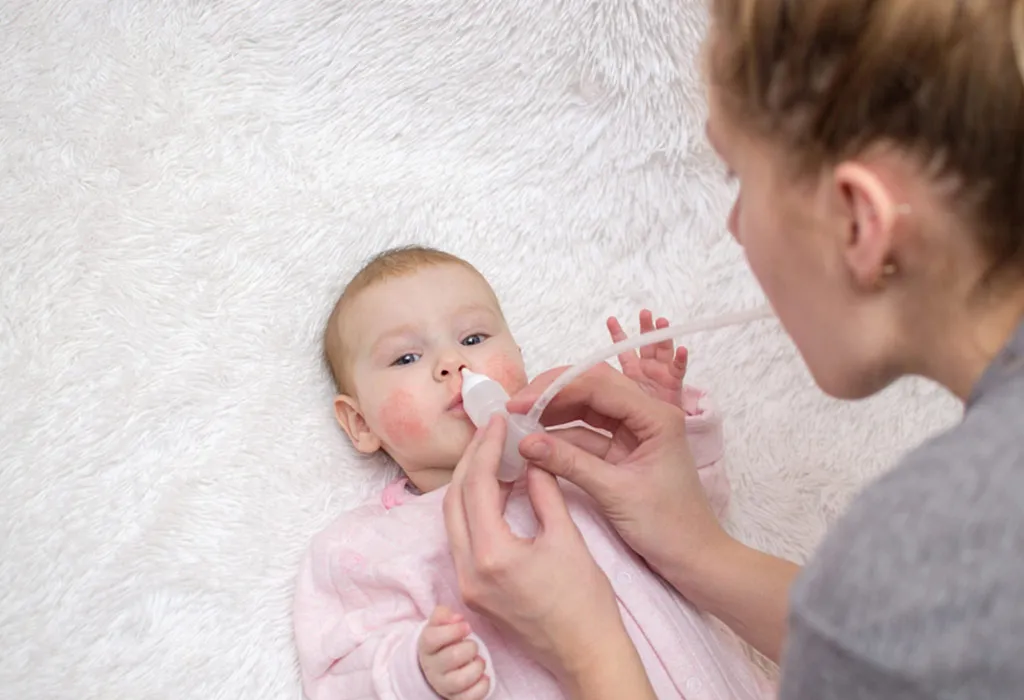How To Treat Croup In Babies: Causes, Symptoms, and Remedies
Do you find yourself awake in the middle of the night, listening to your baby’s harsh, barking cough, feeling helpless and worried? This scenario is all too familiar to parents dealing with croup in their little ones. Understanding how to treat croup in babies is essential to providing prompt care and easing your child’s discomfort.
In this comprehensive guide on how to treat croup in babies, we delve into the causes, symptoms, and remedies for this respiratory condition. From the distinctive barking cough to signs of respiratory distress, we cover it all to equip you with the knowledge needed to navigate through this challenging situation.
Here’s what you can expect to learn in this blog:
- Insights into the most common cause of croup in babies
- Symptoms that differentiate croup from a common cold
- Effective home remedies and care tips for managing croup symptoms
- When to seek medical attention and the importance of early intervention
Stay tuned as we provide you with a roadmap to effectively understanding and managing croup in babies. Let’s empower you with the tools to give your little one the care they need during this trying time.
Introduction to Croup in Babies

Croup is a respiratory illness that primarily affects babies and young children. It is usually caused by a viral infection, most commonly the parainfluenza virus. Croup causes inflammation in the upper airway, leading to symptoms such as a barking cough, fever, and difficulty breathing.
Babies between the ages of six months and three years are most susceptible to croup due to the smaller size of their airways. The condition tends to be more prevalent during the colder months, peaking in late fall and early winter.
Recognizing the early symptoms of croup is crucial for prompt intervention. The distinct barking cough, often described as similar to the sound of a seal or a dog, is a key indicator of croup. Other symptoms may include a sore throat, runny nose, and a hoarse voice.
Timely treatment is important to alleviate symptoms and prevent complications. While most cases of croup can be managed at home, severe symptoms require medical attention. It is essential to consult a healthcare provider if your baby experiences severe breathing difficulties, shows signs of dehydration, or if you are concerned about their overall condition.
By understanding the signs and symptoms of croup and seeking prompt treatment, caregivers can effectively manage this respiratory illness and ensure the well-being of their little ones.
Understanding the Symptoms of Croup

Recognizing the common symptoms of croup in babies is essential. By understanding the distinctive features of croup cough compared to a regular cold or flu, caregivers can take prompt action to alleviate their baby’s discomfort.
Here are the key symptoms to watch out for:
Barking Cough
- One of the hallmark signs of croup is a barking cough that resembles the sound of a seal or a barking seal.
- This cough is often described as harsh, dry, and deep.
- It may get worse at night, causing increased distress for both the baby and their caregiver.
Stridor
- Stridor is a high-pitched, wheezing sound that occurs when the baby inhales.
- It is caused by the narrowing of the airway due to swelling and inflammation.
- If you notice your baby making this sound, especially during periods of rest or activity, it could be a symptom of croup.
Fever
- In some cases, croup can be accompanied by a mild fever.
- However, it’s important to note that not all babies with croup will develop a fever.
- If your baby does have a fever, it is usually low-grade and may range from 100.4°F (38°C) to 101.3°F (38.5°C).
Difficulty Breathing
- Croup can cause varying degrees of breathing difficulties in babies.
- You may observe rapid breathing, increased effort to breathe, or retractions (visible inward movement) in the chest, just above the collarbones, or between the ribs.
- These signs indicate that the baby’s airways are narrow and struggling to take in enough oxygen.
Hoarse Voice
- Another symptom to watch for is a change in the baby’s voice.
- Croup can cause hoarseness or a raspy tone when the baby cries or speaks.
It is important to remember that the severity of the symptoms can vary from baby to baby. If you notice any of these symptoms or suspect your baby may have croup, contact their healthcare provider for an accurate diagnosis and appropriate treatment. Acting promptly and providing the necessary care can help ease your baby’s discomfort and ensure their speedy recovery.
Diagnosing Croup in Babies

When it comes to diagnosing croup in babies, healthcare providers rely on a combination of physical examination and, in some cases, imaging tests. The doctor will start by assessing the baby’s symptoms, such as a barking cough, hoarseness, and difficulty breathing. Using a stethoscope, they will examine the baby’s throat and listen to their breathing patterns.
In certain situations, a chest X-ray or other imaging tests may be recommended to rule out other conditions or to assess the severity of croup. Prompt and accurate diagnosis is crucial to ensure appropriate treatment measures are taken to manage croup effectively in babies.
Home Remedies for Croup in Babies

When it comes to managing croup symptoms in babies, there are several effective home remedies that can provide relief. If you’re wondering how to treat croup in babies, here are some remedies you can try:
1. Humidifier use
- Use a humidifier in your baby’s room to keep the air moist.
- This can help ease their breathing and soothe their irritated airways.
2. Steam therapy
- Run a hot shower and sit with your baby in the bathroom for a few minutes to create a steamy environment.
- The steam can help reduce coughing and loosen mucus.
3. Fluid intake
- Ensure your baby stays hydrated by offering them plenty of fluids.
- Breast milk or formula can help soothe their throat and alleviate discomfort.
4. Elevate the head
- Elevate your baby’s head slightly by raising the mattress or using a pillow.
- This can help ease breathing and reduce coughing.
5. Nasal saline drops
- Use saline drops to clear your baby’s blocked nose.
- This can make it easier for them to breathe and reduce congestion.
Remember, these remedies can provide temporary relief but may not cure the underlying cause of croup. If your baby’s symptoms worsen or if they have difficulty breathing, it’s important to seek medical attention.
Medical Treatment Options for Croup in Babies

When it comes to managing croup in babies, various medical treatment options are available to alleviate symptoms and promote a faster recovery. The primary goals of medical treatment for croup in babies are to reduce airway inflammation, relieve breathing difficulties, and target the underlying viral infection.
Here are some commonly utilized treatment options:
1. Over-the-counter Fever Reducers
- Over-the-counter medications like acetaminophen or ibuprofen can help reduce fever associated with croup.
- However, it’s crucial to consult a healthcare provider for the appropriate dosage based on the baby’s age and weight.
2. Prescribed Medications
- In severe cases of croup, healthcare providers may prescribe medications to ease symptoms and reduce airway inflammation.
- These medications might include a single dose of oral or inhaled corticosteroids, such as dexamethasone or budesonide.
- Steroids help in reducing swelling and inflammation in the airways, leading to improved breathing.
It is important to note that all medications should be administered under the guidance and supervision of a healthcare professional. They will determine the appropriate dosage and duration of treatment based on the baby’s condition and medical history.
In addition to these medical treatment options, it is crucial for caregivers to create a comfortable environment for babies with croup.
- This includes maintaining proper humidity levels within the room to soothe the airways.
- Utilizing a cool-mist humidifier or taking the baby into a steamy bathroom can help alleviate congestion and reduce coughing.
Remember, while medical treatments can provide relief for croup symptoms, it is essential to consult a healthcare provider for accurate diagnosis and guidance. Early intervention and appropriate medical management can help babies recover smoothly from croup and prevent complications.
When to Seek Medical Attention

If your baby is experiencing severe breathing difficulties or showing signs of dehydration, it is crucial to seek immediate medical attention for croup.
Some warning signs that indicate the need for prompt medical intervention include:
1. Severe Breathing Difficulties
If your baby is struggling to breathe, has a rapid breathing rate, or shows signs of chest retractions (the skin between the ribs pulls inward during breathing), it is essential to seek medical help.
2. Dehydration
Croup can cause excessive sweating, difficulty in taking fluids, and decreased urine output. If your baby is showing signs of dehydration, such as a dry mouth, sunken eyes, or infrequent wet diapers, seek medical attention.
Remember, prompt medical intervention can help manage severe croup symptoms and prevent any complications. Don’t hesitate to consult your healthcare provider for proper evaluation and treatment.
Preventive Measures for Croup in Babies

To minimize the occurrence of croup in babies, implementing preventive measures is crucial. By following these simple steps, you can reduce the risk of recurring episodes:
1. Regular hand washing
- Encourage proper hand hygiene among caregivers, family members, and anyone who interacts with the baby.
- Washing hands with soap and water for at least 20 seconds helps prevent the spread of viruses that cause croup.
2. Avoiding exposure to sick individuals
- Limiting contact with individuals who have respiratory infections, especially if they show symptoms of croup, can help prevent transmission.
- Be cautious during peak croup season, typically in the fall and early winter.
3. Maintaining a healthy environment
- Keep the baby’s immediate surroundings clean and free from potential respiratory irritants.
- Regularly disinfect frequently touched surfaces and toys.
- Ensure proper ventilation and air circulation in the living spaces.
Remember, if your baby has a known croup trigger, such as exposure to a specific allergen, it’s essential to address and manage that trigger accordingly. Creating a safe and hygienic environment is key to reducing the chances of croup in babies.
For more detailed information on croup, its symptoms, and treatment options, please refer to the other sections of this comprehensive guide.
The Final Note: How To Treat Croup In Babies
Understanding how to treat croup in babies is crucial for caregivers. Prompt recognition of symptoms, appropriate treatment, and preventive measures are essential for effectively managing croup in babies. By being aware of the signs of croup and seeking timely medical attention, caregivers can provide the necessary care to alleviate symptoms and ensure the well-being of their baby.
Throughout this comprehensive guide, we have discussed the symptoms, diagnosis, and treatment options for croup in babies. We have also explored home remedies and medical interventions that can help alleviate symptoms and provide relief.
Remember, when dealing with croup, it is important to closely monitor your baby’s condition and seek medical attention if you notice severe breathing difficulties, signs of dehydration, or worsening symptoms. It is vital to consult with a healthcare professional for a proper diagnosis and individualized treatment plan.
- To prevent recurring episodes of croup, practicing good hygiene, such as regular handwashing and avoiding exposure to sick individuals, is essential.
- Additionally, maintaining a healthy environment and keeping babies away from known triggers can significantly reduce the risk of croup.
By proactively managing croup and following the guidance, caregivers can provide the best possible care for their babies and support their recovery. Stay informed, seek medical advice when needed, and create a safe and healthy environment for your little one.






